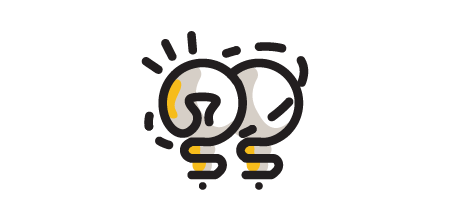our methodology
A design process centered around user testing and iteration.
The most critical piece of the design process is actually testing and iteration: the best, truest, and most impactful solutions come not from the initial brainstorming, but from making revisions based on genuine experience with users.
the mindset
think by doing
Reason through concrete action and experiments, not hypothetical discussion.
customer first
Put the user’s reality front and center, and build a solution out of that.
make magic
A product is a magic moment of visceral connection where their eyes light up.
benchmark iteration
Run dozens of low cost experiments in just a few days, and revise continuously.
design using data
Separate hypotheses and educated guesses from data-driven outcomes.
tackle the top risk first
Identify the most important things you don’t know and solve one at a time.
the learning loop
process
the simulation user test
At the heart of Prototype Thinking’s unique technique is the simulation-based user test. The vast majority of pertinent user behavior and reaction is subconscious, but classic user interview techniques chiefly reveal conscious opinions. By putting the user in a simulation mindset using simple tools, we cause them to exhibit reactions and surface assumptions they didn’t even know they had. This critical tool allows us to get profoundly essential insights early and cheaply.
Check out the video below for an example of an (expedited for demo purposes) simulation user test. As you observe the user’s reaction, note carefully that the most important information lies not in he is saying, but his body language and vocal intonation.
Although the setup itself may appear simple, this is not just any paper prototype test: The technique has been precisely refined using our team’s decades of experience in emotional simulation design in order to quickly reveal the right insights.
other tools
PUPPET PROTOTYPING
Diagrams, drawings, and text on paper can be used to simulate websites or apps, packaging, service descriptions, and informational materials of all types. Physical environments can be built out of props and signs. In places where people would interact or perform a service, an actor can take the role. Where software would automatically provide feedback, a human can manually puppet the paper prototypes. These very low fidelity prototypes allow user testers to focus on the essential material content of what’s presented, rather than on details of the UX or design, and have the added advantage of being easy to modify instantaneously.
REAL-TIME CHANGES
Rather than iterating on a design only after a series of tests, we make dozens of modifications during the course of each user test, sometimes even putting the user on hold for 5 minutes to rapidly rebuild the design. This allows us to get responses to a range of possibilities, a broad picture of tradeoffs and contrasts, and repeatedly pivot closer to what is most compelling to that user while they remain in front of us.
STORYBOARD SEPARATELY
The secret about team debate is that the team is usually 90% in agreement, but most effort is spent on the 10% where they differ. We use a storyboarding tool to help each participant outline their thoughts separately so that it is immediately obvious where overlaps and differences lie, what the consensus areas look like, and most importantly which differences truly, meaningfully matter.
THE TREE
During a Sprint, each team creates a heat map of all ideas explored, insights gained, and diverging design possibilities by visually laying them out in a tree of branching options. This all-time favorite tool allows a team to immediately visualize which options generate the strongest possibilities, succinctly share their work with others, and plan out next steps.
RANKING RISKS
Prototype Thinking allows us to take control of uncertainty by solving the biggest risks immediately through experimentation. Throughout the Sprint, teams will constantly be ranking and reprioritizing their biggest unknowns and tackling them one at a time. They focus on the most important areas first and build a stable base as they progress.
ITERATIVE IDEATION
One key feature that distinguishes Prototype Thinking from other design methodologies is that we do not separate ideation and testing stages. Rather than waiting for a single brilliant idea to run with, we begin immediately with the best guess available and jump to action. Through quick testing, we build a clearer and clearer picture of the challenge space in iterative layers, re-ideating each time to reach a transformative solution that works on multiple levels at once.










